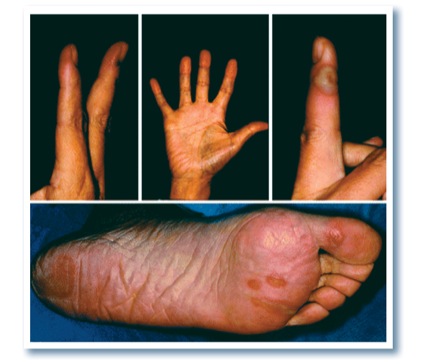Effective Hand–Foot Syndrome Treatment Identified
Phase II, randomized trial has some clinicians changing practice
Chicago—Urea-based skin creams can reduce the incidence of hand–foot skin reactions (HFSR) in patients treated with sorafenib (Nexavar, Bayer), according to results from a large Phase II, open-label, randomized study. An example of this skin cream is Eucerin (Beiersdorf, Inc), a commonly available product.
The finding, reported at the annual meeting of the American Society of Clinical Oncology (abstract 4008), has already spurred practitioners to make changes.
“I would definitely recommend Eucerin cream in patients who are on sorafenib,” said Ed Chu, MD, chief of Hematology/Oncology and deputy director of the University of Pittsburgh Cancer Institute, who was not involved with the study. “It might also be interesting to use Eucerin cream with other drugs that are associated with hand–foot syndrome, such as the oral fluoropyrimidine Xeloda [Roche], and I’ve already discussed this with my nurse and mid-level provider,” he said.
Hand–foot skin reactions occur in 21% of patients who are treated with sorafenib for unresectable hepatocellular carcinoma and 30% of patients who receive this drug for advanced renal cell carcinoma.
Investigators of the new study, which was conducted at 64 centers in China, enrolled patients with advanced hepatocellular carcinoma who were sorafenib-naive. Approximately 900 patients were given sorafenib and randomized to concomitant best supportive care (BSC) or BSC plus urea-based skin cream. The treatment arms were well balanced in terms of baseline patient characteristics.
Patients who were treated with the skin cream had a significantly lower incidence of all-grade HFSR within 12 weeks (56.0% vs. 73.6%; P<0 .0001=".0001" 29.2="29.2" 2="2" as="as" em="em" grade="grade" hfsr="hfsr" nbsp="nbsp" vs.="vs." well="well">P
=0.004). The prophylactic use of urea-based cream improved health-related quality of life, reducing symptom burden and the effect of symptoms on daily activities. Grade 2 HFSR is characterized by skin changes, such as peeling, blisters, bleeding, edema or pain that does not interfere with function. Grade 3 HFSR is ulcerative dermatitis or skin changes with pain that interferes with function.The researchers also found that the median time to the first HFSR event was 2.5-fold longer in patients who received the skin cream than in those who did not receive it (84 vs. 34 days;P<0 .0001=".0001" p="p">“This is important because sorafenib is the most effective agent in hepatocellular cancer, but it is a marginally effective agent,” said Colin Weekes, MD, PhD, an assistant professor of Medical Oncology at the University of Colorado School of Medicine in Denver. “When we look at an agent that may not benefit everybody, it is nice when we might be able to delay the toxicity for those patients who aren’t going to turn out to have a benefit.”The finding, reported at the annual meeting of the American Society of Clinical Oncology (abstract 4008), has already spurred practitioners to make changes.
“I would definitely recommend Eucerin cream in patients who are on sorafenib,” said Ed Chu, MD, chief of Hematology/Oncology and deputy director of the University of Pittsburgh Cancer Institute, who was not involved with the study. “It might also be interesting to use Eucerin cream with other drugs that are associated with hand–foot syndrome, such as the oral fluoropyrimidine Xeloda [Roche], and I’ve already discussed this with my nurse and mid-level provider,” he said.
 Examples of hand-foot syndrome. |
Investigators of the new study, which was conducted at 64 centers in China, enrolled patients with advanced hepatocellular carcinoma who were sorafenib-naive. Approximately 900 patients were given sorafenib and randomized to concomitant best supportive care (BSC) or BSC plus urea-based skin cream. The treatment arms were well balanced in terms of baseline patient characteristics.
Patients who were treated with the skin cream had a significantly lower incidence of all-grade HFSR within 12 weeks (56.0% vs. 73.6%; P<0 .0001=".0001" 29.2="29.2" 2="2" as="as" em="em" grade="grade" hfsr="hfsr" nbsp="nbsp" vs.="vs." well="well">P
Sheng-Long Ye, MD, of the Zhongshan Hospital, Fudan University, in Shanghai, China, who presented the research at the meeting, said the study was limited in that it did not document the extent to which the patients used the moisturizing skin cream.
—Kate O’Rourke
No comments:
Post a Comment